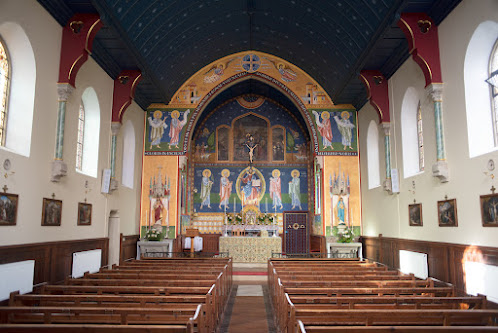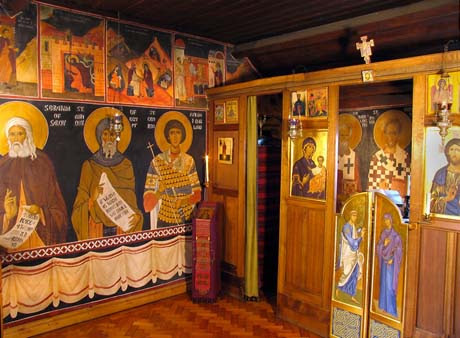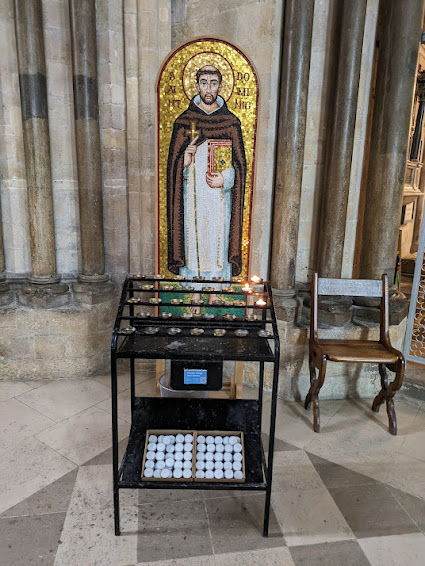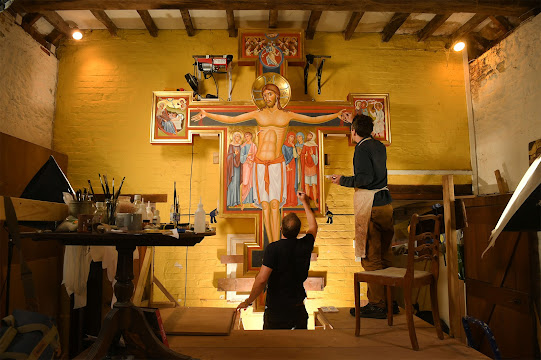An Authentic Formation in Master Sacred Artists in the Manner of Medieval Guilds
The Chichester Workshop for Liturgical Art provides a unique model for the re-establishment of authentic traditions in sacred art and the evagelization of the culture, and which should be a prototype for others. It has been established under the leadership of the renowned iconographer, Aidan Hart and two of his senior former students, who are now masters in their own right, taking commissions and teaching others to the highest level.
This is a call for enlightened patrons to want to help establish an updated system of apprenticeship by commissioning art which mirrors the medieval guild system in its teaching practice. By doing so they will not only be contributing to the creation of work that will inspire faith and right worship for centuries; they will also be helping to train the multipliers of this tradition – Masters who not only continue the tradition through their work, but also pass on what has been established by training others.
The Chichester Workshop for Liturgical Art was established under the patronage and support of the Anglican Bishop of Chichester, the Right Rev. Dr Martin Warner, and is multidenominational. Aidan is Orthodox and his colleagues, Jim Blackstone and Martin Earle are Anglican and Roman Catholic respectively. Each has a fully liturgically centered understanding of what the Church is and understands deeply how to harmonise the form and content of sacred art with the right worship of God within their denominations. You can see their individual work on their websites here: Aidan Hart, Jim Blackstone, Martin Earle. They are able to take commissions in the US as well as the UK.
This is a workshop in which each Master takes on apprentices in a focussed, traditional model that is tailored to the individual strengths and weaknesses of the student and brings them up to the Master level quickly. They take on people who already have a high degree of artistic ability and training, but need the final, high level training – post-doctoral level, if I can call it that – that produces the person who is capable of taking on commissions in painting, sculpture, mosaic, stained glass or fresco and can teach others in these disciplines also.
These Masters will only consider students who are committed to the mission of evangelization and want to pass on to others in turn what they learn. Each student is carefully selected. They must be open to direction, have a strong mission-oriented faith, and have the artistic talent. In this sense it is more on the Medieval guild model of bespoke personal training and personal formation, than that of the Academy model that developed in the High Renaissance and which used in the ateliers that teach classical naturalism today.
The method of the Workshop is also a way of training multipliers – artistic missionaries, so to speak – who can re-establish and propogate an athentic paradigm of tradition that will hand-on the positive experience and wisdom of past generations.
I spoke to a typical student, who is a Roman Catholic and member of an Anglican Ordinariate church Maryland. He approached Aidan after completing three years of training in classical naturalism in the academic method at an atelier in Baltimore. He recognised that his training, which imparted great skill in drawing and painting, did not give him the additional formatio that would enable him to paint liturgical art that is truly in harmony with the sacred liturgy of the Church. He will travel regularly to the UK to work alongside Aidan in his workshop, he will spend focussed periods with the other Masters in order to learn specific skills, such as mosaic.
This is where you, dear readers, come in. It is a call for patrons of the arts. The high level students are there, but funding is needed to pay for the time of these Master artists to teach them. Every hour spent with a student is one in which these professional artists are not earning a living as an artist for their families.
If you are interested you can help in two ways. One is to fund a student by paying tutorial fees, plus room and board for a student. Perhaps you know someone in your congregation who you would want to support and who could in turn create beauty in your own church? Funding such a person would be establishing a local model of art creation in which all the congregation will feel part of what is happening and so will want to safeguard once it is created. They will feel personally involved and engage with it more readily in their worship.
The cost of such a training would be less than the fees at a conventional art school or classical naturalism atelier, perhaps of the order of $15,000 per annum all in. Some require just part of year to completion, some will require perhaps a full year or even two.
Alternativeley, and perhaps even more excitingly, you or a group of you could commission a large scale work or a number of transformational works for your church. Then Aidan, Martin or Jim would be able to pay the apprentice to work on the commissions directly. This is the most efficient and effective way to see positive results.
Just to inspire you on what is possible. You could conribute to the transformation of church in the way that the patrons who funded Martin Earle did at Baddesley Clinton in Warwickshire, England.

And to explain how it works: when I was a learning to paint, Aidan engaged taught me fresco by letting me assist him in two projects. One was at the hermitage in Shropshire, the Monastery of St Anthony and Cuthbert. At first I assisted in a lot of the non-artistic work of the project but was observing what Aidan was doing all the time, and talk to him. Ultimately though, I did paint minor details in the frescoe work itself as my teacher gained confidence in me. In this case it was the drapery painted on the walls.

Art of the quality that Aidan, Martin and Jim create will inspire worshipers and future artists for generations. You or your parish could commission, for example, a rude screen as a well as reredos and the frescoes on the walls to create a fully interactive, so to speak, schema of art that engages all during the act of worship.
I would be available to advise on how to design such schemas if anyone needs help in this regard.
I encourage those with funds or with access to them to consider very carefully that value of such beauty and become an enlightened patron playing an absolutely vital part in the evangelization of the culture that will have an effect on the Church and the wider culture, potentially, for centuries.

Those who are interested in commissioning work can contact myself through thewayofbeauty.org or the workshop direct: https://www.chichesterworkshop.org/ or best or contact the artist you wish to commission: Aidan Hart, Jim Blackstone, Martin Earle.

From the Aidan Hart | Beauty | Chichester Workshop | David Clayton | Sacred Art series
View more Posts